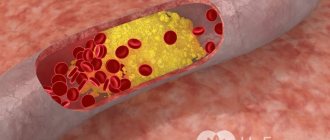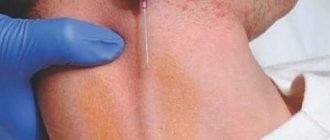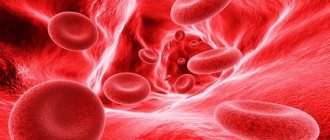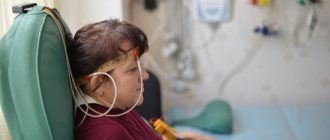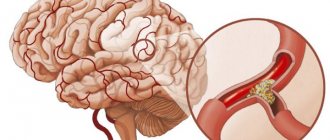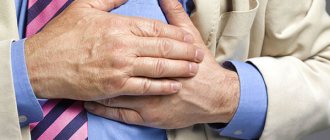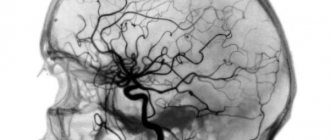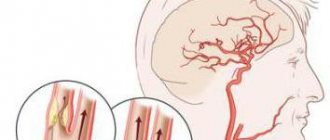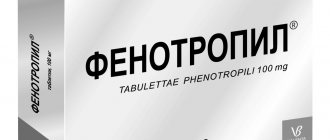Narrowing of the cerebral arteries is a pathological condition that is diagnosed by determining defects in circulatory processes. Vasospasm of cerebral vessels is a short-term, attack-like decrease in the supply of nutrients to the brain. In this case, no significant changes occur, however, it should be noted that against this background, muscle tone changes. Subsequently, this phenomenon can cause a stroke.
Therefore, signs characteristic of vasospasm of cerebral vessels must be treated carefully at any age. Only timely measures can prevent the occurrence of ischemia.
It should be noted that in neurology such manifestations are defined as a vascular crisis.
Vasospasm of cardiac vessels is also possible. This is a sharp and sudden narrowing of the lumen of the arteries, or rather the smooth muscle tissue that lines them. Such a spasm is temporary, but occurs in the form of angina, causing considerable discomfort to the person.
Most often, the pathology is diagnosed in men in middle age. Vasospasm can also occur in a newborn infant who has been injured during childbirth or in adolescents when serious changes in the hormonal system occur.
What happens in the vessels?
When we talk about the spastic state of blood vessels, we need to clarify that we mean small arterial branches (capillaries, arterioles). They have a smooth muscle wall that contracts according to all laws:
- the receipt of an impulse along nerve fibers or with the help of special hormonal substances in the blood;
- replacement of necessary electrolyte ions (potassium, sodium, calcium), which change the charge of the cell membrane;
- shortening of muscle fibers (contraction).
Violations occur at one or all stages. It cannot be ignored that spasm of the blood vessels in the head can be caused reflexively in response to cold (walking without a hat in winter), pain in the internal organs, and impaired blood supply at the level of the vessels of the neck (carotid, vertebral arteries).
Development mechanism
The process is based on one of three pathogenetic options. Combinations of factors are possible, but they are rare.
First
Vasospasm (angio- or vasospasm) as a result of a biochemical shift, hormonal cause. A large amount of specific substances from the adrenal cortex are released into the blood: cortisol, norepinephrine.
They provoke a natural narrowing of the lumen of the arteries, spasm and disruption of blood flow, and at the same time an increase in pressure.
Another possible option is the symptomatic production of angiotensin-2, aldosterone, and renin. These substances are responsible for vascular tone.
With excessive synthesis, persistent critical stenosis occurs; with insufficient synthesis, muscle relaxation and weakness of blood flow occur.
There are many reasons for the imbalance: from diseases of the pancreas, thyroid gland, to pathologies of the kidneys, liver, pituitary gland, previous brain injuries, emergency conditions such as stroke, heart failure due to hypertension and others.
Second
Violation of adequate vascular innervation. Regulation of arterial tone occurs not only through hormonal means. Although such a mechanism is considered key in the control and spontaneous adaptation of the cardiovascular system.
Nerve structures are also involved. Angiospasm (another name for acute narrowing of the lumen of an artery) can develop as a result of the receipt of a chaotic, excessive impulse on the tension of the vascular muscles.
Hence the pronounced stenosis, sometimes critical, leading to rupture of the blood supplying hollow structure.
This reason is less common. It can be the result of tumors of the central nervous system, previous injuries, brain infections, autoimmune and genetic, chromosomal abnormalities.
Third
Angiospasm (this is another name for the condition) develops against the background of toxic tissue damage. As a response to stimulation by toxic substances. Arterial stenosis can develop as a result of smoking and drinking alcohol.
Experience doesn't matter much. Both a person who takes a puff for the first time in his life and an avid fan of “tarring” can suffer. Alcohol has the same effect. Depends on the individual reaction of the body to toxic components.
The line between spasm of blood vessels and atherosclerosis is thin. Because the second may also include a sharp narrowing of the arteries.
Terminological confusion sometimes complicates making a diagnosis, and then understanding the essence of the disorder when visiting another doctor; work is underway to clarify it.
Why does spasm occur?
The main cause of cerebral vascular spasm is considered to be improper regulation by the autonomic nervous system. This is most clearly manifested by the symptoms of vasospasm against the background of vegetative-vascular dystonia (VSD), a disease of discirculatory disorders. With VSD, spastic contractions are replaced by a sharp dilation (paresis) of the arteries.
There are many diseases that contribute to short-term contraction of arteries:
- damage to cerebral vessels by atherosclerotic plaques, blood clots, the presence of aneurysmal expansion;
- neuroses;
- traumatic injuries of the skull;
- benign and malignant tumors of the brain, pituitary gland;
- hypertension;
- angina attacks;
- changes in the arterial wall with vasculitis, collagenosis;
- endocrine disorders in thyrotoxicosis, obesity, diabetes;
- diseases of the meninges (arachnoiditis, meningitis).
Characteristics and description of the problem
Angiospasm of cerebral vessels is an abnormal narrowing of blood vessels as a result of a decrease in the lumen between their walls due to strong contraction of the muscle layer of the walls for a long period of time, which occurs reflexively. There are many reasons for the development of pathology, and the consequences can be quite serious. This disease is one of the types of acute dystonia.
Typically, cerebral vasospasm appears due to spasm of small vessels, capillaries and arteries, arterioles. The passage of blood through them either stops completely or has limited strength. A consequence of this pathology may be a disruption in the oxygen supply to the brain, which leads to the development of ischemia in the area of brain tissue where the pathological vessel passes.
What triggers attacks?
It has been established that the direct “provocateurs” of dyscirculatory disorders of the brain can be:
- poisoning with toxic substances (salts of heavy metals, carbon disulfide, nicotine during prolonged exposure to a smoky room and smoking, drugs);
- intense mental work, overwork;
- strong emotions, stressful situations in life;
- disturbed sleep, night shift work;
- atmospheric changes (magnetic storms, pressure changes, weather changes);
- abuse of tonic drinks (strong tea, coffee, tonics);
- lack of fluid in the body - dehydration with severe sweating, loss with vomiting and diarrhea.
A predisposition to impaired vascular response is inherited in families where there are hypertension, cases of stroke, acute heart attack.
Headache occurs suddenly when you feel well
Non-drug treatments
Knowledge about how to relieve spasm of the blood vessels in the head is not enough, because the cause of the pathological condition must be eliminated. Kidney treatment, weight normalization, or elimination of problems related to the cardiovascular system may be required. Self-medication in this case can be dangerous. In most cases, spasms of the scalp or brain are treated using conservative methods. They are aimed at strengthening blood vessels and the body as a whole.
- Shock wave therapy is based on the use of acoustic waves. Under their influence, pain is reduced, inflammation processes are stopped, metabolism and blood circulation are normalized. Contraindications include bleeding disorders, hypertension, cancer, acute infections, and fragility of tubular formations.
- Tissue neuroadaptation - low frequency electrical impulses are used. There are biologically active points on the human body, into which the doctor inserts thin needles that conduct current. This is how you can treat headaches.
- Physiotherapy is a set of procedures involving the use of low current, laser, ultrasound, light, and ultraviolet radiation. If there are problems with the spine that provoke spasms of the blood vessels in the head, then they can be solved in this way.
- Head massage - due to smooth movements, it is possible to relieve headaches, relax the nervous system, and normalize blood pressure.
In order to improve the functioning of the vascular system, qualified medical staff recommend completely giving up bad habits, walking outside every day, sticking to a daily routine, and eating right. Hardening, cool douches, and contrast showers have a strengthening effect on the nervous and vascular systems.
Vascular pathology in 30-year-olds is not uncommon today. Angiospasm occurs as a result of a violation of the blood supply to the brain tissue: the lumen of the artery narrows due to sharp intense contractions of the vascular wall. pathology is mandatory due to the high risk of death.
The condition of a person’s blood vessels is largely influenced by his lifestyle, environmental situation and heredity. It’s not for nothing that doctors constantly talk about the need for a work-rest regime. This pathology is often found in workaholics, people working at night or in large industrial enterprises, in workshops with a lack of air.
Periodically occurring spasms can be:
- Constant lack of sleep (the brain must rest at night, the result of lack of sleep is headaches and vasospasms).
- Nervous fatigue (vascular spasm can be triggered by any strong emotion, as well as stressful situations, depression, emotional outburst, unbalanced nervous system).
- Cervical. One of the main causes of vasospasms: impaired blood supply to the vessels of the brain leads to oxygen deficiency and narrowing of the lumen of the arteries.
- Oxygen starvation (with a lack of oxygen, the vessels do not receive the full amount of nutrients, which significantly affects the vascular wall).
- Smoking. Nicotine is the first enemy of blood vessels. Cigarettes destroy the walls of blood vessels and reduce their muscle tone.
Spasms can be a concomitant symptom of other diseases:
- cardiopathology
- vegetative-vascular dystonia
- brain tumors
- hypertension
- aneurysms
- diabetes mellitus
- dysfunction of the kidneys, liver,
At risk are people who react to changes in atmospheric pressure (meteosensitivity) and people who abuse alcohol. The tendency to vascular spasms can be inherited, especially if relatives have encephalopathy, angina, or stroke.
Even a banal walk in severe frost with your head uncovered can cause vascular spasm.
Clinical manifestations
Neurological practice allows us to identify symptoms of short-term vasospasm (narrowing of the diameter of small arteries):
- headache - in the back of the head, temples, temporo-parietal area;
- dizziness (vestibular type of paroxysm) - with a sensation of objects rotating, imbalance, a staggering gait, “unsteady” ground underfoot;
- fainting;
- changes in vision - darkening of the eyes, sensation of “luminous points”, “veil”, loss of visual fields (optical paroxysm);
- short-term loss of orientation and consciousness;
- paroxysmal numbness, weakness, feeling of “pins and needles” in the limbs;
- temporary speech disorder;
- rushes of blood to the head, redness of the face, a feeling of pulsation in the vessels of the head and neck, tinnitus, increased blood pressure;
- sleep disorder;
- attacks of pain in the heart, a feeling of “fading”, palpitations;
- transient pallor and coldness of the hands and feet.
Insomnia during angiospastic crises is characterized by an influx of thoughts
Classification of vasospasms
A pathology such as vasospasm of cerebral vessels can have an acute and chronic course.
Acute vasospasm develops with the rapid onset of clinical symptoms, while the vessels quickly return to normal working condition.
The chronic course of the disease implies a mild, long-term development of symptoms, which has more serious complications, such as ischemic stroke or complete closure of arterial walls.
In addition, vasospasms are classified according to the severity of their development:
- Angiodystonic vasospasms of cerebral vessels are characterized by the development of vasoconstriction in a mild form. Such spasms do not cause major neurological symptoms and quickly return to normal.
- Angiodystrophic - caused by the manifestation of brain symptoms, with manifestations in the form of dizziness, nausea, vomiting, and headaches. After the end of the attack, dystrophic changes in the arteries and capillaries develop.
- Cerebro-necrotic spasms - this type of pathology is closest to the development of a micro-stroke and is caused by the development of a fainting state, a violation of the motor and speech functions of the body.
Different types of severity of the disease are due to the presence of characteristic symptoms and, as a consequence, certain therapeutic measures on which the outcome of the pathology depends.
Types of spasm according to severity
According to the severity, vascular spastic crises are divided into 3 groups:
- angiodystonic - the mildest form, all neurological symptoms are mild, the condition is quickly restored;
- angiodystrophic - after a crisis, transient cerebral symptoms remain in the form of asthenia (weakness, dizziness), vascular changes in the arterial wall reach the stage of dystrophy;
- cerebral-necrotic - there is a short-term loss of consciousness, mild disturbances in motor activity, speech, vision, vomiting, headache, less often patients complain that “the head is filled with lead”, they feel tinnitus, swelling of the eyelids, blue lips are detected.
In severe cases, microcysts or lacunae form in the brain matter.
Depending on the extent of damage, vascular spasms are divided into:
- generalized (general) - characteristic of hypertension, increased blood viscosity, metabolic changes in the brain, typical connections with symptoms of damage to the heart (coronary-cerebral), liver and pancreas (hepatocerebral), kidneys (renal-cerebral);
- regional (local) - if diagnostics reveals a specific zone of spastic vascular contraction.
For example, spastic crises caused by stenosis of the subclavian and vertebral arteries are accompanied by impaired cerebral and local blood supply (fainting, weakness, changes in the sense of balance, pallor, paresthesia, decreased pulsation in the radial artery, cold feet and hands).
You can also read: Signs of cerebral atherosclerosis
Coronary cerebral spasms are characterized by:
- simultaneous development of hypoxia in the brain and heart;
- manifestations of secondary cardiac disorders (angina attacks, arrhythmia).
During hepatocerebral crises, patients complain of pain in the right hypochondrium, nausea, vomiting, and bloating.
Renal cerebral pathology causes severe headache, mild meningeal symptoms, and urinary disorders.
Accurate diagnosis is important for the correct choice of drugs in the rational treatment of the patient's condition.
Causes, symptoms and treatment
The process of formation of cerebral arteries, including the ACA, is negatively affected by the following factors:
- Drug or alcohol addiction in a pregnant woman;
- Infection of the fetus during intrauterine development;
- Intoxication of a woman’s body during gestation;
- Burdened heredity;
- Pregnant women taking medications that have a teratogenic effect.
Symptoms of the disease and their severity depend on the degree of underdevelopment of the vessel that supplies the brain. Symptoms may present differently in each patient. Some people only find out that they have hypoplastic ACA during a medical examination. Often the disease is asymptomatic.
Hypoplasia of the PMA can manifest itself with the following symptoms:
- Headaches of varying intensity;
- Frequent dizziness;
- Decreased or loss of sensitivity of the skin;
- Instability of blood pressure;
- Emotional disorders;
- Disorders of perception and sensations.
All of the listed symptoms indicate insufficient cerebral circulation, so if they occur, contact the neurologists of the Yusupov Hospital. Doctors will first conduct a comprehensive examination, which includes the following diagnostic procedures:
- Ultrasound examination and Dopplerography of cerebral vessels;
- Contrast angiography;
- Computed or magnetic resonance imaging.
Sonologists use modern ultrasound machines that combine a triplex scanner and a Doppler unit. They make it possible to visualize the extracranial and intracranial sections of the arteries of the vertebral-basilar region and identify the asymmetry of blood flow in the MCA and ACA. To determine the state of neurons during cerebral ischemia, magnetic resonance and computed tomography are performed using premium devices. CT angiography of cerebral vessels at the Yusupov Hospital is performed on a modern scanner. Using it, not only step-by-step images of cerebral vessels are obtained, but also their three-dimensional model. These images can be viewed on a computer monitor, printed on film, or transferred to a DVD+R disc.
If the symptoms of cerebrovascular accident caused by dysplasia of the ACA are mild, therapy is carried out with drugs that dilate the arteries and normalize cerebral blood flow. Conservative therapy helps reduce the intensity of headaches and improve the functioning of the vestibular apparatus. When a blood clot is detected in an abnormal vessel, the doctor prescribes medications to dissolve it. Neurosurgeons at partner clinics of the Yusupov Hospital carry out correction of the pathology of the ACA in cases where there is no positive dynamics with drug treatment. The stenting technique is mainly used for ACA hypoplasia.
Diagnostic methods
In case of a mild course of the disease, the diagnosis is made based on the exclusion of other most severe brain diseases, because changes in the blood vessels cannot be detected after spontaneous relief of the spasm.
Neurologists and angiosurgeons use for examination:
- duplex scanning of the intracerebral and brachiocephalic branches of the cerebral arteries, it is possible to register the consequences of frequent vascular spasms in their moderately severe course;
- MRI of vessels;
- computed tomography of the brain.
If the above methods are not possible, contrast radiography is performed.
Dopplerography of blood vessels allows us to detect the slightest damage to the walls
What is the danger of vasospasm
Angiospasm can mask more serious organic diseases - blockage of an artery with a blood clot or cholesterol plaque, tumor, rupture of a vessel. These pathologies can develop into ischemic or hemorrhagic stroke.
A long period of oxygen starvation with constant spasm is also dangerous because it is accompanied by metabolic disorders and destruction of brain tissue.
With reduced elasticity, cracks may appear on the inner layer of blood vessels and blood may stagnate. This is how blood clots form. If they reach large sizes, there is a risk of blockage of large vessels and arteries.
The insidiousness of the disease lies in masking the clinical picture of the disease:
- stroke;
- the appearance of aneurysms;
- malignant neoplasms;
- hemorrhages.
As you know, a disease is easier to prevent than to treat, so special attention should be paid to preventive measures:
- proper nutrition;
- healthy sleep;
- physical exercise;
- massage and hardening procedures.
A prerequisite for maintaining health is regular observation by a doctor. This is especially true for people with a predisposition to this disease.
What should be changed
Before prescribing treatment, the doctor will require the patient to change their lifestyle and give up harmful habits:
- it is necessary to stop smoking and drinking alcohol;
- be sure to arrange outdoor recreation, evening walks;
- do morning exercises, try to master yoga and self-hypnosis techniques;
- do not allow long breaks in your diet, ensure you drink plain water (up to 2 liters per day), stop abusing strong coffee and tea, replace them with herbal teas with mint and lemon balm, dried fruit compote;
- in the diet to restore the tone of the vascular wall, you need porridge (from cereals, not flakes), raw fruits and vegetables, seafood (fish, plants), lean meat, dairy products, hard cheeses. You will have to limit spicy snacks, fried and fatty meats, cakes, and carbonated drinks.
Compliance with the regime often allows young people to get rid of the manifestations of pathology and restore proper regulation of vascular tone. If clinical manifestations occur against the background of other chronic diseases, then you will have to additionally use drugs that affect cerebral circulation.
Possible reasons
Vasospasm of the vessels of the head can occur for the following reasons:
- dysfunction of the muscular layer of the artery walls;
- changing the order of functions performed;
- increased contraction of arterial walls;
- failure of the muscle walls.
The cause of vasospasm may be the following diseases:
- hypertonic disease;
- hydrocephalus;
- osteochondrosis of the upper spine;
- angina pectoris;
- cerebral aneurysm;
- pathologies of the membranes of the brain;
- kidney disease;
- diseases of the thyroid gland associated with disorders of its functions;
- diabetes;
- suffered traumatic brain injuries.
Attention! Cerebral vasospasm occurs as a result of aneurysm damage. The spasm itself represents a certain protective reaction of the body to prevent hemorrhage.
Doctors notice that the trend of vascular pathologies is increasing. This is primarily due to the rhythm of life of modern man and the difficult environmental situation. Life in large cities leaves its mark on the cardiovascular system.
Among the list of causes of dyscircular disorders are:
- intoxication of the human body with heavy toxic substances;
- constant mental work;
- overwork;
- excessive physical activity;
- psycho-emotional exhaustion;
- sleep disturbances, night work;
- changes in atmospheric pressure;
- excessive consumption of caffeinated drinks;
- lack of fluid in the body.
It should be remembered that the manifestation of vascular spasm is also influenced by a hereditary factor, that is, such a predisposition can be laid down at the genetic level.
There are characteristic signs of vasospasm of cerebral vessels, and their manifestation is a special reason to seek medical help.
Among the list of the most common symptoms that are characteristic signs of vasospasm are:
- severe headaches of a generalized or local nature;
- dizziness;
- memory impairment as a result of changes in the nature of blood circulation;
- excessive fatigue;
- noise in ears;
- decreased performance.
It is worth remembering that cerebral vasospasm manifests itself sharply and unexpectedly. Its symptoms are no different from the manifestations of other types of vascular spasms.
A distinctive feature is the presence or even worsening of characteristic manifestations after several days.
Present changes in blood flow are assessed if the following symptoms are present:
- muscle weakness on one side of the body;
- speech dysfunction;
- lack of physical strength;
- dullness of reaction;
- visual field impairment;
- nausea;
- numbness of the limbs.
Only a doctor can promptly identify and diagnose the presence of spasm. This is due to the fact that the characteristic symptoms are not unique and can characterize not only vasospasm, but also other conditions.
Treatment of cerebral arterial spasm
Treatment methods for vascular spasm are related to the main causes of the pathology and diseases leading to its occurrence.
- In the treatment of hypertension and atherosclerosis, antihypertensive drugs and drugs to reduce the level of low molecular weight cholesterol fraction (statins) are important.
- To relieve vasospasm, tablets from the group of calcium antagonists (Corinfar, Adalat) are used.
- To relieve pain in severe headaches, the following are used: Eufillin, Papaverine, No-shpa, Papazol. The doctor will recommend use in the form of injections or orally.
- Sedatives such as motherwort tincture, valerian or stronger drugs (Seduxen, Relanium) normalize the vascular reaction.
- To influence metabolic processes in brain tissue, a group of nootropics (Nootropil, Piracetam) is used, Trental is prescribed.
- Cavinton, Cerebrolysin, Actovegin have vasotonic properties.
- According to the patient's indications, it is possible to recommend medications to improve the adaptive response to the environment (tinctures of aralia, ginseng, eleutherococcus, lemongrass).
- You need multivitamins with microelements or separately nicotinic acid, vitamin E, group B.
Patients are recommended physiotherapeutic treatments and massage. People get a good and long-lasting effect after staying at resorts. Especially if a climatic zone, natural stimulants in baths and mud applications, and mineral waters are used.
Possible complication in the form of arterial thrombosis after spasm
Treatment
It is possible to combat spasm of cerebral vessels only with the help of complex therapy. It is aimed at:
- relaxation of vascular walls due to the effect on their muscular system;
- reduction of nervous tension;
- normalization of blood pressure;
- providing an antispasmodic effect;
- preventing the formation of blood clots.
Important information: How to treat stenosis of the left (right) subclavian artery and what are the symptoms of the disease
Treatment of cerebral spasm is carried out using medications and traditional medicine.
Drug treatment
- Drugs of the statin group (Vasilip, Atokor). The drugs lower cholesterol levels, preventing the formation of foci of atherosclerosis.
- In the complex treatment of vasospasm, drugs from the calcium antagonist group are used. One of the representatives of medicines is Corinfar.
- The fight against pain is carried out using antispasmodic and analgesic drugs. To quickly stop an attack, they can be used in the form of injections (No-spa, Papaverine, Magnesium sulfate).
- It is possible to normalize blood circulation in the vessels of the brain using nootropic drugs (Nootropil, Phezam, Thiocetam).
- To improve cellular nutrition, Actovegin, Cerebrolysin, Thiotriazolin are prescribed.
- For asthenic syndrome, tinctures of lemongrass, eleutherococcus or aralia are used.
- As a complex therapy for vasospasm, nicotinic acid and B vitamins are prescribed.
- To combat dizziness and tinnitus, drugs containing betagestin (Betaserc, Vestibo, Betagis) are used.
Traditional methods
Traditional medicine cannot replace basic treatment. They are used as additional therapy. Vasospasm can be eliminated with the help of herbal remedies prepared from chokeberry, chamomile, St. John's wort and dandelion root. Infusions and decoctions are prepared from prepared plant materials. Use them for 2-3 weeks. Then you should take a break.
Stopping an attack at home
If vasospasm occurs suddenly to the patient, then you can get rid of its symptoms using the following therapeutic methods:
- lie on the bed so that your head is in an elevated position;
- perform a light head massage;
- dissolve a teaspoon of honey in a glass of warm water and drink in small sips;
- take an antispasmodic agent that relaxes the walls of blood vessels (Spazmalgon, No-shpa);
- If the cause of the attack is stress, then you need to take a sedative.
Important information: Symptoms (treatment) of cerebral vasospasm and how to quickly relieve vasospasm of the arteries of the head using folk remedies
If headache attacks recur, you should definitely seek medical help.
A patient suffering from vasospasm is recommended to lead a healthy lifestyle, maintain a drinking regime (drink at least 1.5 liters of water per day), do not neglect night rest, and walk more in the fresh air.
How to relieve an attack at home?
To quickly relieve an attack at home, distracting reflex procedures are used:
- warm herbal tea with honey;
- washing with cold water or ice;
- cold foot baths for 10 minutes;
- massage in the temporal region, in the “collar” zone of the cervical spine.
Healthy:
- rub your forehead and temples with “Star” ointment;
- take 20 drops of Corvalol or valerian tincture;
- Chew and swallow one tablet of Aspirin, Ibuprofen, Spazgan.
In case of repeated attacks, you should consult a doctor and undergo a full examination. This is the only way to find out which treatment can really help.
Diagnostic criteria
After the manifestation of vasospasm, the patient must undergo a full examination, which includes:
- laboratory methods for analyzing urine and blood;
- magnetic resonance imaging;
- computed tomography.
A complete examination eliminates the risk of concomitant pathologies.
Vasospasm can be a symptom of the following dangerous pathologies:
- hypertonic disease;
- vegetative-vascular dystonia;
- hypoxia;
- hyponatremia;
- hydrocephalus.
For the timely detection of vasospasm, the following methods are used:
Testing using similar methods can be done in a public hospital or in a private diagnostic clinic. The price of the event may vary significantly.
The most informative picture can be obtained by conducting a series of studies. That is, to obtain a clear picture of changes, it is important to conduct surveys based on different methods.
Attention! It is visually impossible to determine the presence of changes in the vessels. This is due to the fact that there are no characteristic signs of pathology; this condition is individual for each patient.
Due to the fact that during the initial examination it is impossible to determine the presence or absence of changes, a thorough examination is required. In any case, the doctor must follow the instructions, which involve interviewing the patient and assessing the clinical picture of the disease.
The video in this article discusses the main diagnostic techniques and their diagnostic ability in identifying spasms. It is important to remember about the serious complications of the pathology, therefore treatment should be carried out immediately.
Folk recipes
Traditional recipes are applicable in cases of vasospastic symptoms. The recommendations do not differ in the mechanism of action from medical guidelines.
The famous recipe of garlic, honey and lemons is undoubtedly recommended for everyone, as it has a positive effect on the blood vessels, immunity and mood of the patient.
For herbal tea, rose hips, nettle leaves, mint, lemon balm, currants, and lingonberries are recommended.
Diagnosis and treatment measures for spasm of cerebral arteries will help prevent serious consequences in the form of early stroke, thromboembolism and cerebral infarction. In children, this pathology causes delayed general and mental development, persistent migraine attacks, decreased vision and hearing. Timely consultation with a doctor allows you to avoid irreparable damage to your health.
Pathology therapy
Treatment of cerebral vasospasm will depend on the cause of its development. If you only eliminate the symptoms of the disease, it will appear again after a while. When determining the primary disease, all efforts must be directed toward its elimination. Once the cause of the disease is eliminated, the symptoms will subside.
But it is not always possible to identify the cause of the disease, and therefore it is not possible to eliminate it. In this case, the doctor develops a treatment strategy that will include changing the patient’s lifestyle.
People with vasospasm of cerebral vessels must remain in bed for four weeks. Drug therapy includes taking the following drugs:
- the action of the drugs is aimed at eliminating infection in the brain;
- painkillers in the form of intravenous injections of “No-shpa” or “Revalgin”;
- sedatives (sedatives), for example, Motherwort;
- tranquilizers: “Relanium”, “Seduxen” and others;
- nootropic drugs: “Piracetam”, “Nootropil” and others;
- drugs for normalizing cerebral vessels: Cavinton, Cerebrolesin;
- vitamin complexes;
- adaptogens: lemongrass, ginseng.
Reasons for the development of cerebral vasospasm
To date, a number of causes have been identified that cause cerebral arterial vasospasm. Under their influence, a reflex compression of the vascular wall and the muscular part of the capillary or artery occurs. This causes a stoppage or complete absence of blood flow to the brain area.
The main reasons that can develop vasospasm are:
- dysregulation of the autonomic nervous system (due to malfunction of the walls of blood vessels caused by diseases such as hypertension, tumor formations in the brain, angina pectoris, concussions, blood clots);
- strong and rapid contraction of the walls of arteries and capillaries caused by hereditary factors or previous diseases;
- thrombophlebitis, as a result of which blockage of the capillary walls develops and the supply of oxygen and blood to tissues and cells decreases.
In addition to these reasons, there are a number of factors that influence the development of the pathological process;
- neuroses and mental disorders;
- vegetative-vascular dystonia;
- bad habits (smoking, alcohol, taking potent drugs);
- disorders of the body's endocrine system (diabetes mellitus);
- cardiovascular pathologies;
- previous concussions;
- hydrocephalic lesions;
- increased stress, fatigue;
- low fluid intake;
- lack of sleep;
- large consumption of coffee and strong tea;
- increased hazards in the workplace associated with difficult working conditions.
Specifics of pathology in a newborn
In a newborn, vasospasm of blood vessels is called vasospasm. It is a condition in which the lumen of blood vessels is reduced, which causes pathological changes in the blood supply and blood flow to brain structures.
Vascular spasm in a child, especially a newborn, which continues for a long time, can become a source of oxygen starvation and cause various nervous disorders. The causes of this phenomenon can be various negative factors, mainly in newborns these are diseases of the spinal cord and spinal column, often of a traumatic type.
At risk for vascular spasm in the brain are newborns and older children who have the following conditions:
- transference of birth trauma;
- cerebral palsy;
- spinal column injury;
- back injuries;
- lack of attention;
- hyperactivity;
- diseases of the nervous system;
- increased weather sensitivity.
Vasospasm of cerebral vessels in newborns can manifest itself in different ways, but there are some signs that are found in all clinical cases.
The most common specific symptom of cerebral vasospasm in childhood is dizziness and headaches. Newborns in the first year of life often cry almost constantly due to headaches and sleep poorly. Often, babies do not want to eat and behave too restlessly.
In addition to pain, vascular spasm in the brain can be accompanied by a number of symptomatic signs:
- rapid and excessive fatigue;
- lethargy unusual for a baby;
- weakness of legs and arms;
- nausea.

